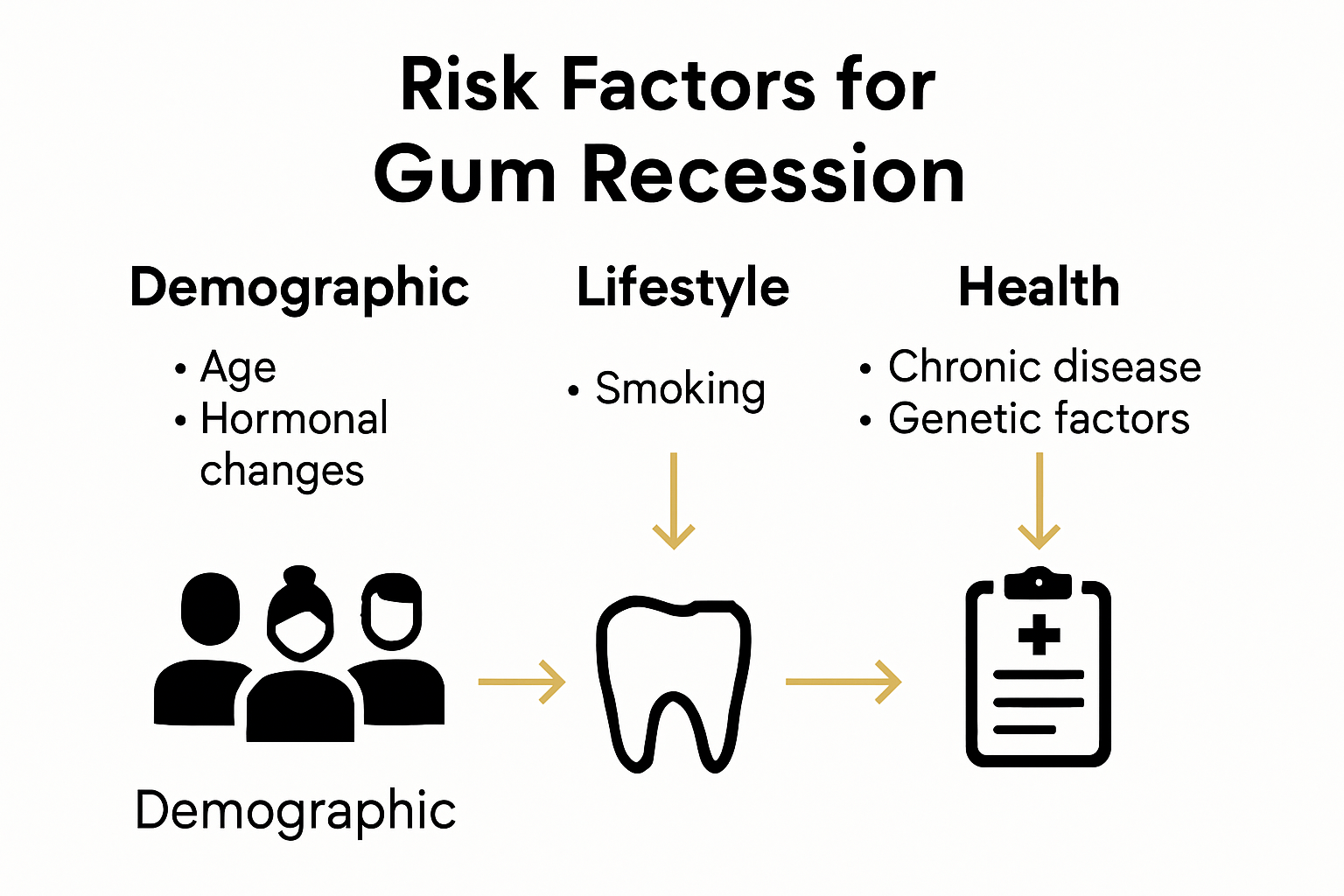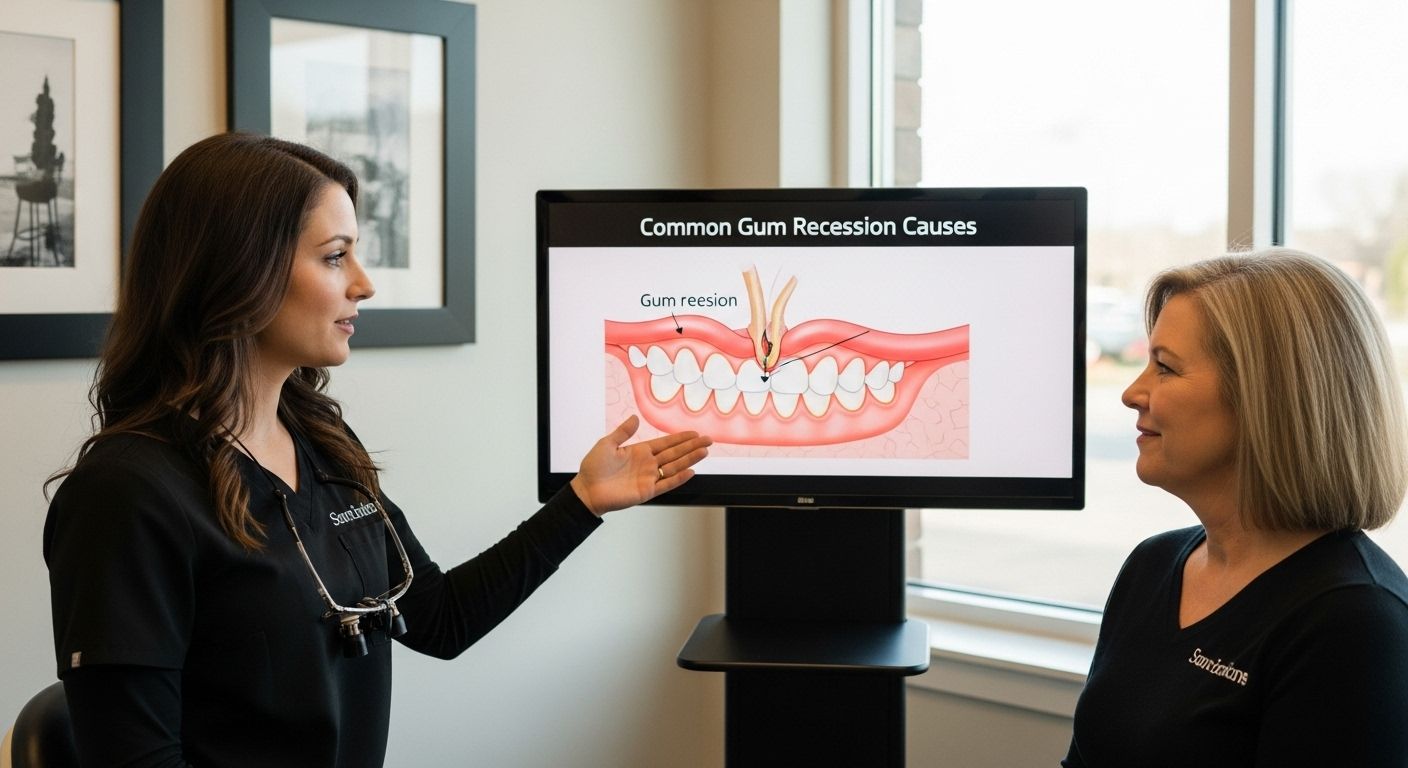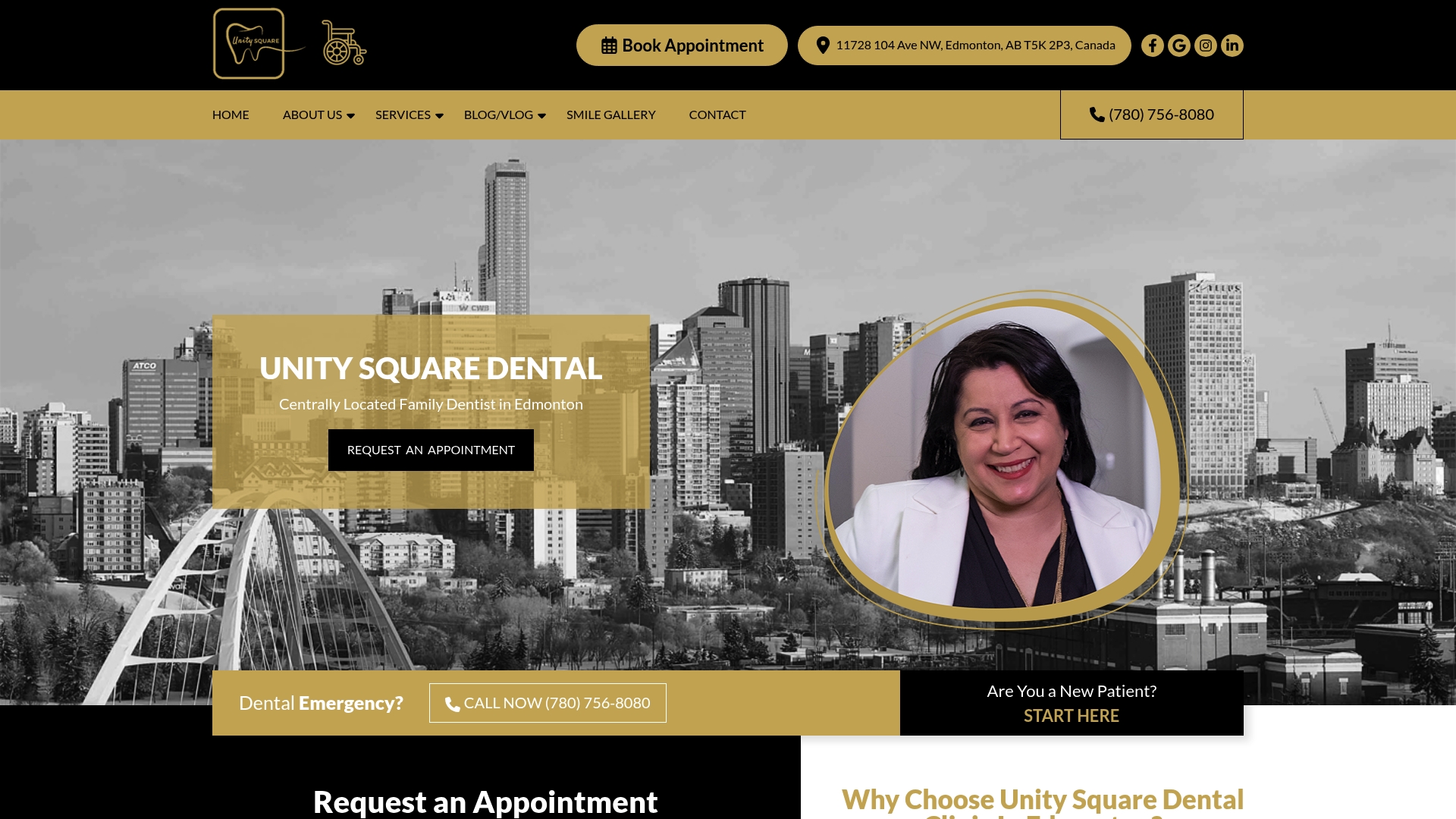
Gum recession can sneak up on families in Edmonton and cause major trouble before you even notice it happening. Most people would assume this is just a problem for the elderly, but research shows that nearly 41 percent of people between ages 15 and 60 already have noticeable gum recession. That flips the script on what you might expect, and it means the risks—and the prevention—matter much earlier and wider than most realize.
Table of Contents
- What Is Gum Recession And Why It Matters
- Common Gum Recession Causes In Edmonton
- Who Is Most At Risk For Gum Recession
- How To Prevent And Manage Gum Recession Locally
Quick Summary
| Takeaway | Explanation |
|---|---|
| Gum recession is a common issue. | Nearly 41% of individuals aged 15-60 experience gum recession, highlighting its prevalence. |
| Aggressive brushing can worsen gum health. | Overzealous brushing and hard bristles can damage delicate gum tissue, leading to recession. |
| Age increases gum recession risk. | Individuals over 40 are at higher risk; hormonal changes also impact gum health. |
| Regular dental check-ups are crucial. | Biannual visits help detect and manage gum recession early, preventing complications. |
| Lifestyle choices significantly affect gum health. | Factors like smoking, nutrition, and stress impact gum recession risk, making healthy habits vital. |
What Is Gum Recession and Why It Matters
Gum recession represents a significant dental health concern that can silently compromise your oral wellness. Understanding this condition is crucial for protecting your long-term dental health and preventing potential complications.
The Fundamental Definition of Gum Recession
Gum recession occurs when the soft tissue surrounding teeth gradually pulls back or wears away, exposing the tooth’s root surface. Research from the Cleveland Clinic reveals that this condition happens incrementally, often going unnoticed until more advanced stages develop. The exposed root becomes vulnerable to sensitivity, decay, and potential bone loss, making early detection and intervention critical.
A comprehensive epidemiological study found that 40.98% of individuals aged 15-60 experience gingival recession, highlighting how widespread this dental issue truly is. The prevalence increases with age, suggesting that proactive dental care becomes increasingly important as we grow older.
Primary Indicators and Potential Risks
Recognizing gum recession involves understanding its subtle yet significant warning signs. Typical indicators include:
- Tooth Sensitivity: Increased sensitivity to hot, cold, or sweet stimuli
- Visible Root Exposure: Teeth appearing longer than normal
- Loose Tooth Feeling: Potential movement or shifting of teeth
CDC research on oral health emphasizes that untreated gum recession can lead to more serious periodontal complications. The exposed root creates an entry point for bacteria, potentially triggering inflammation and progressive gum disease.
Beyond immediate dental concerns, gum recession can signal underlying health issues. Factors such as aggressive brushing, poor oral hygiene, genetic predisposition, hormonal changes, and smoking can all contribute to this condition. Understanding these risk factors empowers individuals to take proactive steps in maintaining optimal oral health.
For Edmonton families seeking comprehensive dental guidance, understanding early prevention strategies becomes paramount in managing potential gum recession risks. Regular dental check-ups, proper brushing techniques, and a holistic approach to oral wellness can significantly mitigate the progression of this condition.
Common Gum Recession Causes in Edmonton
Understanding the specific factors contributing to gum recession helps Edmonton residents proactively protect their oral health. Multiple interconnected causes can trigger this progressive dental condition, requiring comprehensive awareness and strategic prevention.
To help Edmonton residents understand the different causes of gum recession, the following table summarizes the main contributing factors discussed in the article along with supporting examples or details.
| Cause Category | Examples & Details |
|---|---|
| Aggressive Oral Hygiene | Brushing too hard, using hard-bristled toothbrushes, incorrect brushing angles |
| Systemic Health & Genetics | Hormonal changes (puberty, pregnancy, menopause), genetic predisposition, chronic inflammatory conditions, diabetes, autoimmune disorders |
| Lifestyle & Environment | Smoking, poor nutrition, chronic stress, inadequate dental hygiene |
Aggressive Oral Hygiene Practices
Contrary to popular belief, overzealous dental care can actually harm gum health. Research from the American Dental Association indicates that aggressive brushing techniques can significantly contribute to gum recession. Many Edmonton residents unknowingly damage their gum tissue by:
- Brushing Too Hard: Using excessive force while brushing
- Using Hard-Bristled Toothbrushes: Abrasive tools that wear down gum tissue
- Incorrect Brushing Angles: Applying lateral pressure that erodes gum line
Dental professionals recommend using soft-bristled toothbrushes and employing gentle, circular motions to maintain gum integrity.
Systemic Health and Genetic Factors
The Centers for Disease Control and Prevention highlights that gum recession is not merely an isolated dental issue but often reflects broader health conditions. Genetic predispositions and systemic health challenges play crucial roles in gum tissue vulnerability. Key contributing factors include:
- Hormonal changes during puberty, pregnancy, and menopause
- Genetic susceptibility to periodontal diseases
- Chronic inflammatory conditions
- Autoimmune disorders
- Diabetes and metabolic syndrome
Individuals with family histories of dental problems or specific health conditions should be particularly vigilant about their oral health monitoring.
Lifestyle and Environmental Influences
Lifestyle choices significantly impact gum health. Smoking, poor nutrition, chronic stress, and inadequate dental hygiene create an environment conducive to gum recession. The National Institute of Dental and Craniofacial Research emphasizes that lifestyle modifications can dramatically reduce recession risks.
For Edmonton families seeking comprehensive dental insights, our detailed guide on preventing gum disease offers expert strategies for maintaining optimal oral wellness. Understanding these multifaceted causes empowers individuals to take proactive steps in preserving their gum health and preventing long-term dental complications.
Who Is Most at Risk for Gum Recession
Understanding the specific demographic and health profiles most susceptible to gum recession helps Edmonton residents take proactive preventive measures. Certain groups face higher risks due to a combination of physiological, lifestyle, and genetic factors.
The following table provides a quick overview of key risk groups and factors for gum recession as presented in the article. This makes it easy to identify specific vulnerabilities for targeted prevention.
| Risk Factor/Group | Description & Details |
|---|---|
| Age (Over 40) | Increased rates of gum tissue deterioration with age |
| Hormonal Changes | Pregnancy, menopause, puberty—heightened sensitivity or inflammation |
| Chronic Health Conditions | Diabetes, cardiovascular disease, autoimmune disorders, compromised immunity |
| Lifestyle/Behavioral Factors | Smoking, chronic stress, teeth grinding, poor nutrition, inadequate hygiene |
| Genetic Predisposition | Family history of dental or periodontal disease |
Age and Hormonal Demographic Risks
Research from the Centers for Disease Control and Prevention reveals that age plays a significant role in gum recession vulnerability. Individuals over 40 experience higher rates of gum tissue deterioration, with risk factors intensifying as people age. Hormonal transitions present particularly challenging periods for oral health:
- Pregnancy: Hormonal fluctuations increase gum sensitivity
- Menopause: Reduced estrogen levels impact gum tissue resilience
- Puberty: Hormonal changes can trigger temporary gum inflammation
These hormonal shifts create an environment where gum tissues become more susceptible to recession and potential damage.
Chronic Health Condition Vulnerabilities
The American Academy of Periodontology highlights that certain chronic health conditions dramatically increase gum recession risks. Individuals managing the following health challenges face heightened oral health vulnerabilities:
- Diabetes with poor glucose management
- Autoimmune disorders
- Cardiovascular diseases
- Chronic inflammatory conditions
- Compromised immune systems
These health conditions can compromise the body’s natural healing mechanisms, making gum tissues more prone to recession and potential deterioration.
Lifestyle and Behavioral Risk Factors
The University of Iowa’s College of Dentistry emphasizes that lifestyle choices significantly impact gum health. High-risk behaviors and characteristics include:
- Smoking and tobacco use
- Chronic stress
- Poor nutritional habits
- Teeth grinding or clenching
- Inadequate oral hygiene practices
- Genetic predispositions to periodontal issues
For Edmonton families seeking comprehensive insights into managing these risks, our specialized guide on preventing gum disease provides targeted strategies for maintaining optimal oral wellness. Understanding these risk factors empowers individuals to make informed decisions about their dental health and implement preventive measures effectively.

How to Prevent and Manage Gum Recession Locally
Edmonton residents have multiple proactive strategies to prevent and manage gum recession, ensuring long-term oral health and minimizing potential complications. Understanding local resources and implementing targeted preventive measures can significantly reduce individual risk factors.
Professional Dental Care Strategies
The National Institute of Dental and Craniofacial Research emphasizes the critical role of routine professional dental care in preventing gum recession. Local Edmonton dental professionals recommend:
- Regular Dental Check-ups: Biannual comprehensive examinations
- Professional Cleaning: Removing plaque and tartar buildup
- Early Intervention: Identifying and addressing potential recession signs
- Personalized Treatment Plans: Tailored approaches based on individual oral health profiles
These professional interventions provide comprehensive monitoring and proactive management of potential gum health issues.
Personal Oral Hygiene Techniques
Implementing precise and gentle oral hygiene practices can dramatically reduce gum recession risks. Recommended techniques include:
- Using soft-bristled toothbrushes
- Adopting gentle, circular brushing motions
- Utilizing fluoride toothpaste
- Incorporating daily flossing
- Using antiseptic mouthwash
- Practicing proper brushing angle techniques
Local dental experts suggest that technique matters more than aggressive brushing, emphasizing gentle and consistent oral care.
Lifestyle and Nutritional Considerations
Beyond direct dental care, lifestyle modifications play a crucial role in maintaining gum health. Edmonton residents can protect their oral wellness by:
- Quitting tobacco use
- Managing stress levels
- Maintaining balanced nutrition
- Staying hydrated
- Controlling underlying health conditions
- Monitoring hormonal changes
For Edmonton families seeking comprehensive guidance, our specialized gum disease prevention guide offers targeted strategies for maintaining optimal oral health. By combining professional care, personal hygiene practices, and holistic lifestyle approaches, individuals can effectively prevent and manage gum recession risks.

Frequently Asked Questions
What is gum recession?
Gum recession occurs when the gum tissue surrounding teeth pulls back or wears away, exposing the tooth’s root surface. This condition can lead to increased sensitivity and other dental complications if left untreated.
What are the main causes of gum recession?
Common causes include aggressive oral hygiene practices like brushing too hard, systemic health issues such as hormonal changes and genetic predisposition, and lifestyle factors such as smoking and poor nutrition.
How can I prevent gum recession?
Preventing gum recession involves using a soft-bristled toothbrush and gentle brushing techniques, maintaining regular dental check-ups, and adopting healthy lifestyle choices like quitting smoking and managing stress.
Who is most at risk for gum recession?
Individuals over 40 years old, those experiencing hormonal changes (like pregnancy or menopause), and those with chronic health conditions or poor oral hygiene habits are at increased risk for gum recession.
Protect Your Family from Gum Recession in Edmonton
Gum recession can seem invisible at first but the impact on your family’s comfort and long-term dental health is real. As described in the article, issues like tooth sensitivity and root exposure can appear suddenly. For concerned parents and individuals in Edmonton, understanding why gums recede is only the beginning. You want reliable solutions so you can stop worrying about hidden dental problems and protect your loved ones. Unity Square Dental specializes in early detection and tailored treatments for gum recession. From gentle checkups to advanced periodontal therapy, our compassionate team uses modern technology to give families peace of mind and practical results. Learn how we address common pain points like aggressive brushing habits, lifestyle influences, and age-related gum changes through our patient-focused approach.

Take control of your family’s gum health now. Visit Unity Square Dental to see how our accessibility, weekend hours, and experienced practitioners make prevention and care simple and stress-free. Ready for specific advice about gum recession prevention? Explore our blog for expert tips and facts and book an appointment today so you stay ahead of gum disease and protect every smile in your home.
Recommended
- Chewing Gum and Dental Health: What Edmonton Families Should Know – Unity Square Dental
- Gum Disease and Heart Health: Edmonton Families’ Guide 2025 – Unity Square Dental
- Is Teeth Whitening Safe? 2025 Edmonton Family Guide – Unity Square Dental
- Dental Care for Families in Edmonton: Your 2025 Guide – Unity Square Dental

